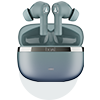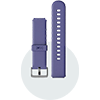You love your headphones, we geddit! But finding the perfect headphones today can be as difficult as finding a needle in a haystack, especially if you are not familiar with all the technology that comes with it. No matter what features a pair of headphones boasts about, we know you still buy it solely on the basis of how slick it looks and how powerful the sound is. 🤪
And that’s okay, but would it hurt to know how that powerful sound is produced for you?
You know Mitochondria is the powerhouse of a cell, right? 👀 Well, today we’ll be talking about the powerhouse of headphones. Yes, in today’s episode of ‘Know What You Buy’, we’ll be introducing you to the all powerful and mighty, ‘Headphone Drivers’.
To put it simply, a driver is responsible for creating the sound that you hear in your ear! You can imagine them to be like tiny loudspeakers in your ear. They convert electrical signals into sound. They are made up of 3 components namely voice coils, magnets, and diaphragm!
Is Bigger Always Better? (Pun NOT Intended)

Now, some of you think that the quality of sound is linearly related to the size of the driver and in order to get better sound quality, you need to get headphones with bigger driver size. But that is not completely true! Whereas a larger driver will have a larger diaphragm, which basically means cleaner bass. However, headphones with large drivers can also struggle in reproducing high frequencies.
Does The Number Of Drivers Matter?

Well, some headphones do come with more than one driver. Do you know why? Because a single driver holds the capacity to produce sound between 20Hz and 20KHz, but there are certain limitations involved there. That’s why some earphones use multiple drivers. With multiple drivers involved, filtering is used to segregate the range of frequencies and this allows each driver to focus on a particular range.
But then again, it doesn’t mean that a headphone with multiple drivers is going to sound better, when compared to the one with a single driver!
‘Ugh, you’re getting us all confused 🤯’. Okay, calm down, soldier. Let’s simplify this phenomenon for you even further. 🖖
Types of Drivers (Shit’s About to Get Serious)
Dynamic Drivers (Moving Coil Drivers)

These are the most common types of drivers that you come across as they are mostly affordable. They create sound by using the physics of electromagnetism and magnetism to create movement.
If you want your headphones to produce a thick bass puch, then go for the ones with dynamic drivers. They do a marvelous job in delivering impactful bass and deliver good sound without consuming much power.
However, they are widely popular and highly effective, some people complain that they produce harmonic distortion at loud volumes. But there’s nothing that some good engineering can’t fix!
Planar Magnetic Drivers
These are the types of drivers that you will find in most of the high-end headphones, which are open-back, over-ear or in-ear in design! They are kind of similar in their mechanism to the dynamic drivers as they operate using a magnetic field, but rather than using a coil, the diaphragm, which is a thin flat film, becomes directly affected by the magnetic field. This results in the creation of sound.
They house additional magnets so that the whole diaphragm can vibrate evenly. This results in adding a bit of weight to the headphones. This also means that the headphones will consume more power from the audio source. But the sound that they deliver is accurate, clean and crisp. They accentuate every detail without any distortions. They can be called the perfect choice for the audiophiles!
Balanced Armature Drivers
They are very small in size and are mostly used in in-ear monitors. Due to their compact size, manufacturers put multiple drivers in a single earpiece. They are extremely good at sound isolation and let you enjoy a detailed listening experience. However, on the downside, these drivers face a lot of difficulty in producing a good bass response (especially when compared to the dynamic drivers).
They are good for gaming!

Electrostatic Drivers
They are rarely found in open-back headphones and are extremely expensive. They utilise static electricity to produce sound - like charges, they repel each other which produces vibrations as the diaphragm pushes and pulls against two conductive plates. The air is pushed by the diaphragm through the perforated walls and sound waves are creative with the variation of electrical signals.
The sound is of breathtaking quality, which surpassed all expectations! If you can afford them, buy them and experience the true meaning of music!
Bone Conduction Drivers (Magnetostriction Drivers)
They are fairly new in the market and do not work like other headphone drivers. They let you enjoy your music by vibrating your face bones, interesting right?
They need to be pressed against the bones in your face so that the sound can pass to your inner ear using vibrations!
They are good for people who would like to be aware of their ambient surroundings while listening to their music. Their only drawback is that they do not produce sound that is as great as the other drivers.
Phew! 🥵 That was TMI, right? But don’t worry. Next time your friend asks you which headphones they should buy, stun them with your smart insights about headphone drivers. 😉
Now, go on. We have more blogs to work on, ugh. 🤒



































